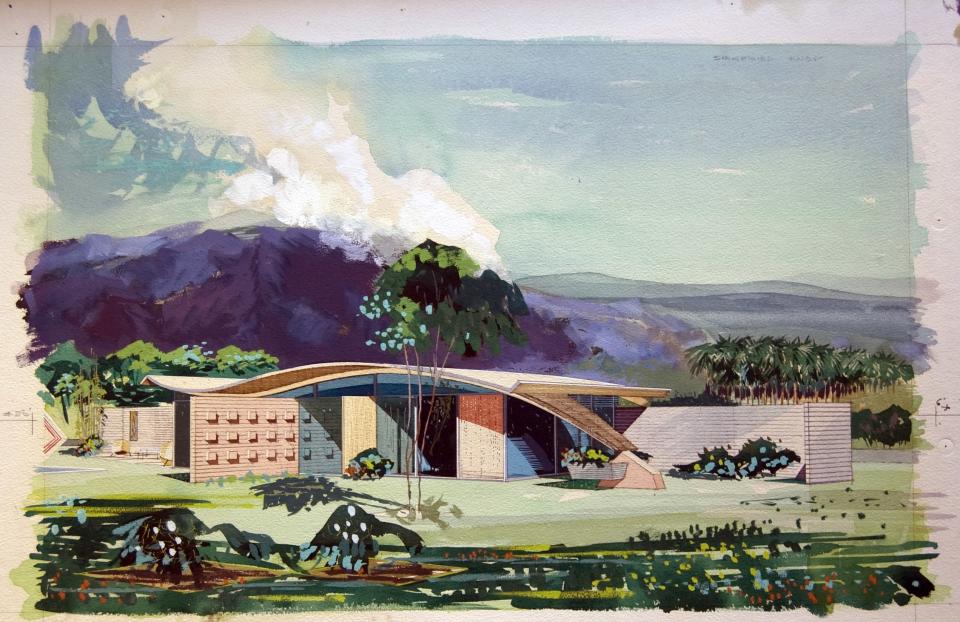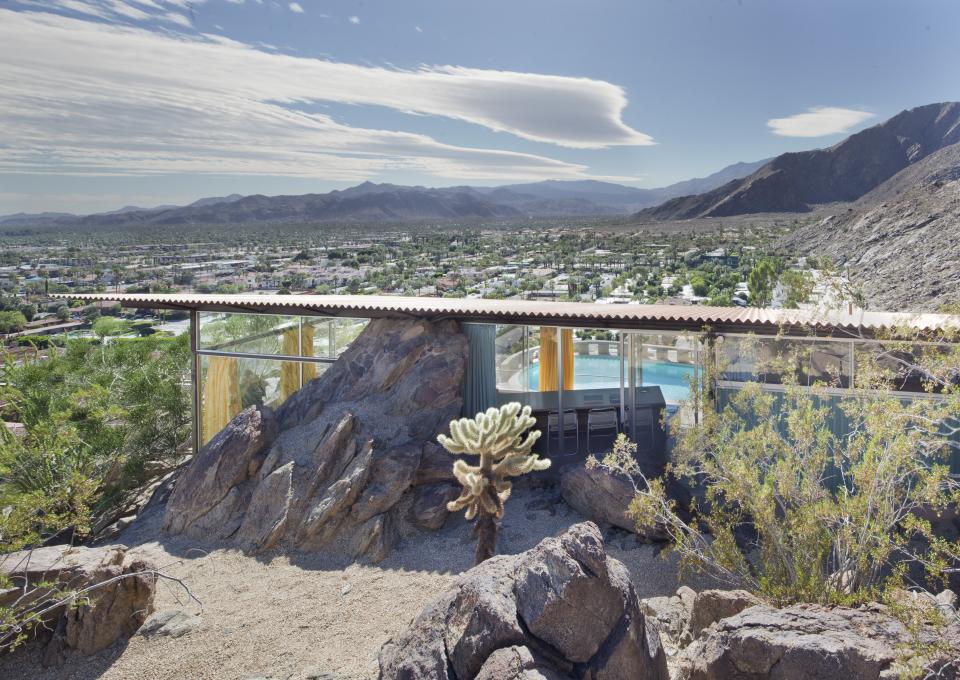Is the Real-Estate Industry Saving Palm Springs's Midcentury-Modern Homes?
"I'm starting at $1 million," began the auctioneer in the auditorium of the University of California Riverside's Palm Desert campus.
No one answered.
He went lower. Still no answer.
Someone yelled out "$50,000." And they started there.
This is the way architect Gil Stayner retells—still with a bit of disbelief—how, in less than five minutes of live bidding, he and his son, Christian, won architect Walter S. White's Miles C. Bates house for $360,000. It was February 24, the closing weekend of Modernism Week and the 1950s home—known to most as the Wave House, for its hyperbolic-paraboloid wooden roof undulating above concrete block and glass walls—had been opened to visitors and prospective buyers for a three-day open house.
"We have pretty firm policies against open house events," explains Modernism Week executive director Lisa Vossler Smith. "No for-sale signs, no realtor materials, no one soliciting the house during the tour. But this was a different story."
The city’s redevelopment agency had purchased the home—called the most significant project from White's vast Coachella Valley oeuvre—in 2007, with initial plans to raze the property and make room for an affordable housing development. But when the Historical Society of Palm Desert got wind of the news, it led an effort to "Save the Wave," which landed the house on the National Register of Historic Places. The final step? Finding a buyer who would honor the history of the house. To incentivize that, the city even threw in $50,000 in matching funds for the property's restoration.
"This is the first time that one of our local cities has put their money where their mouth is," continues Smith. "They realized they had this property and there were opportunities to preserve it. This is also the first time that one of our local cities hosted a real-estate auction of an important midcentury home. Ten years ago they would have just looked the other way and it would have been bulldozed."
Notably, there is a third first here: This is the first house on the Modernism Week roster with a for-sale sign.
But for years, despite on-paper efforts to keep commerce out of Modernism Week—a festival in its 13th year that serves to educate the public on the area's historic midcentury homes and raise money for the organizations that protect them—the seven-plus days of programming, house tours, and events have functioned as a savvy marketing tool for selling them. In Palm Springs, something quickly becomes apparent: Selling a house—to the right owner—is preserving it.

"It requires such a budget to sustain these houses," says Smith. "It’s often better in the hands of a private owner they might be in a different financial position than a museum of preservation organization."
A picturesque town just a two-hour drive from L.A. that's warm and sunny 365 days a year? It's no surprise that Palm Springs and the neighboring Coachella Valley towns became a playground for Hollywood heavyweights in the early 20th century. But, with the advent of air-conditioning in the 1950s, houses no longer mandated strict design features to handle the 100-degree summer days. Now, you could trade windows and natural ventilation for hard-lined steel and a glass curtain walls, a perfect frame to the jaw-dropping landscape outside. Enter desert modernism.
With celebrity-scale budgets, from the late 1940s through the '60s wild experiments in the midcentury style popped up across the town's rocky terrain: Richard Neutra's home for department store tycoon Edgar Jonas Kaufmann, John Lautner's 25,000-square-foot spaceship for Bob Hope, and E Stewart Williams' Twin Palms estate for Frank Sinatra were shining stars among a galaxy of experimental pads.
"In Palm Springs alone we’re talking about a midcentury modern architectural archive that is a few thousand homes strong," says Smith.
But more than 60 years after the fact, the gems are deteriorating. Some rare finds, like the Wave House, need ground-up restorations, or they face the same fate as Neutra's Rancho Mirage Samuel and Luella Maslon House, razed in 2002. Meanwhile, the majority are suffering from ill-advised additions or 80s or 90s renovations that have gone out of date. And while many might suggest turning the true stunners into house museums à la Albert Frey's famous Fray II, which perches above the Palm Springs Art Museum, for a city like Palm Springs (and countless others across the country) that lacks the funding and staff to maintain a historic interior, locals have found their own systems for preserving architectural history. Here, that means working together—the city officials, the preservationists, the real estate community (tellingly, some people here belong to several of these categories at once)—to ensure historic homes land in good hands.
"A lot of the real-estate firms, if they're dealing with a historic home, will try to find the right person to preserve it," explains Brooke Hodge, Palm Springs Art Museum's (PSAM) director of architecture and design. "Even if it goes for a really low price, the community understands why."

The need for careful restorations has carved out a niche for people like Jackie Thomas and DeeAnn McCoy of Thomboy Properties, who left their day jobs in Portland in 2010—when the market was at an all-time low—to buy and renovate midcentury-modern houses in and around Palm Springs.
"In 2010 homes for sale or foreclosures were prevalent," explains McCoy. "Finding projects was easy." By the time the market had rebounded—and nearby music festivals like Coachella put Palm Springs back on the map—Thomboy had carved out a wildly productive niche, flipping homes by unsung Palm Springs heroes including Stan Sackley, William Cody, and Hal Lacey.
"These days, " Thomas says, "the houses find us." And that seems like precisely what happened last year when, looking for their next project, they walked into an open house. A Realtor they'd never met walked up to them with a major tip: There was an Albert Frey house for sale in the off-the-beaten-path North End neighborhood. It was in desperate need of restoration, but he wanted them to see it before it went on the market.
The home turned out to be a project designed for tennis-loving W. I. Hollingsworth in 1966. Situated on a sunken lot, the home, pool, and tennis court were hardly visible from the street, earning it the name Hidden Frey. It needed a lot of work. But who—in the business of flipping midcentury-modern homes—could turn down a Frey?
"They sold it to us for basically what they bought it for," says Thomas. "At first we couldn’t figure out why, but then we realized they wanted to get it into the hands of someone who would love it and restore it."
And that they would. But first they did what they often do when they acquire a property: consult with their real estate representative Keith Markovitz of TTK Represents, an agent team with HK Lane/Christie's International Real Estate.

"They were concerned," says Markovitz. "People have a tendency to scrutinize a heavy-handed approach to a home by a master. They came to us looking for advice on what they can touch and what they can’t; what should be updated for today’s living? In Palm Springs, we have a spectrum of opinions."
In the end, after consulting with Markovitz as well as "staunch preservationist" Chris Menrad, the president of the Palm Spring Modern committee and Realtor at TKK, they made the hard decisions about what to lose and what to keep: They restored Frey's iconic rolled roof, the cantilevered carport, and the elevated pool. They stripped away an incongruous 1980s addition that detracted from Frey's vision, the kitchen cabinetry, and—after much deliberation—the master bath (nearly identical to Frey II's).
"Original Albert Frey bathrooms are cool, but continuity is so important now when you go to the market," explains Markovitz. "The highest and best buyers want the feel of the period, but they want to be able to press on a cabinet and have it work."
Nearly 1,000 people walked through Hidden Frey during Modernism Week. And, while it wasn't technically an open house, it functioned as one. The home went on the market last week for $899,000.
What is lost with all of this, in many cases, is some original detail. But what is quickly evident in Palm Springs is that keeping modernism alive—repurposing it for future generations to come—means not being too obsessive. And isn't that what these architects would have wanted?
"These buildings are living entities," says Hodge. "I don’t think they have to remain exactly the way the architect designed them, like a time capsule. Lifestyles have changed, needs have changed, families have changed."
Stayner, contemplating what he will do with his new piece of architectural history, is the first to admit: "Not everything is possible."
But his goal—the same goal of the city officials, preservationists, and brokers who saw the transaction through—is rather simply put: "To restore the house as closely as we can to its original elegance."


